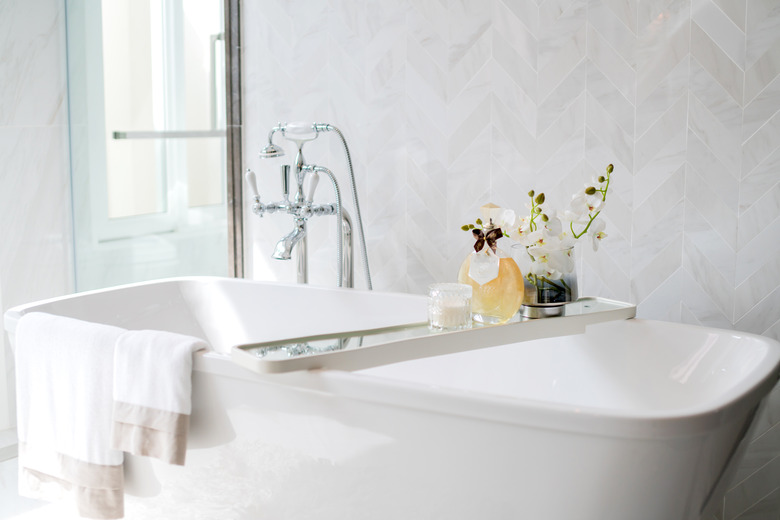How To Fix A Hole In A Metal Bathtub
We may receive a commission on purchases made from links.
When rust is allowed to get out of hand, it can eat a hole through a metal tub. Fortunately, a hole in a metal tub can be repaired fairly easily. The method and materials necessary depend on the size of the hole. For smaller holes no larger than a dime, use a steel-reinforced, two-part epoxy repair product; holes that are any larger require putty.
How to Fix a Hole in a Metal Bathtub
1. Prepare the Work Area
Remove all hardware — faucet, taps, drain and grill — from the tub if it is near the area needing repairs. Lay down a canvas drop cloth to protect the floors from metal shavings and epoxy.
2. Prepare the Tub Surface
Sand the area around the hole with coarse sandpaper to remove the rust, paint, water deposits, soap and dirt, clearing at least a 1-inch border around the opening. Use a putty knife to chip away at stubborn rust, if necessary. Wear a respirator certified by the National Institute of Occupational Safety and Health to protect yourself, since metal and rust shavings become airborne when sanding,
3. Mix the Epoxy
Verify that the surrounding area, both inside and out, is smooth, dry and free from lingering dust particles or rust. Mix the epoxy resin, following all manufacturer instructions. Be sure to follow the specifications with your kit; this is usually mixed with the hardener in a 1-1 ratio, but two-part epoxy ratios may vary.
Mix the epoxy in a small bowl that you can throw away if a container is not supplied in your kit. To yield better control, you could also mix the epoxy on a tile.
4. Apply the Epoxy
Use the provided applicator or a small paintbrush to apply the epoxy in even layers over the hole until the hole is filled. The epoxy sets in four to six hours at room temperature and requires 15 to 24 hours to fully cure. However, setting and curing times may vary, so follow the instructions on the package.
5. Shape the Epoxy Putty
Cut a piece of epoxy putty large enough to cover the hole and knead it until the hardener is activated and the putty turns a uniform color. Then, shape the putty so that it is larger than the hole. Epoxy putty is necessary for larger holes because the repaired area will need to support water weight when the tub is filled.
6. Apply the Epoxy Putty
Place the putty over the hole and press it in place once the hole and surrounding area are smooth, dry and free from dust particles. Follow the instructions to ensure the putty is properly applied and given the appropriate amount of time to set and cure.
7. Test the Repair
Test the repair by refilling the tub with water and checking for leaks once the epoxy is cured. If it was a success, wait until the surface completely dries, and then sand the area to make the repair less visible. Start with a lower-grit sandpaper to level the epoxy to the tub; then follow with increasingly higher-grit sandpaper to ensure the surface is perfectly smooth.
